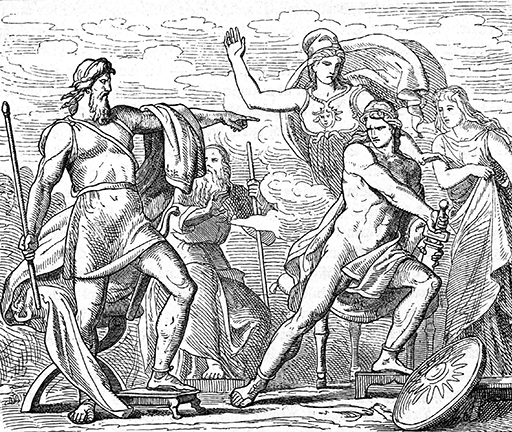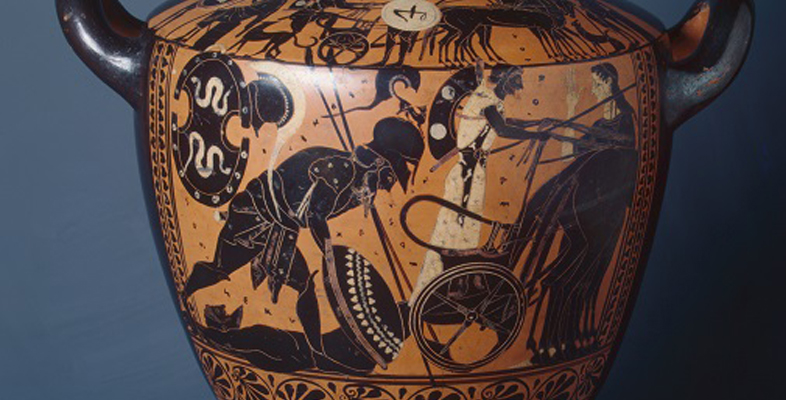3.2 Epithets
Besides the creative use of word order, there were other ways for the poet to work with the strict metrical form of heroic epic poetry. One was the regular use of stock phrases, called formulae, which act as ‘ready-made building blocks’ to fit the metrical structure, often finishing off a line. One particular type of formula is the epithet, a way of referring to characters by different attributes. You’ve already encountered one example that occurs in the very first line: Peleus’ son, which is used to refer to Achilles.
Activity 7
Read the first seven lines again, and see how many more epithets you can spot.
Sing, goddess, the anger of Achilles, Peleus’ son,
the accursed anger which brought the Achaeans countless
agonies and hurled many mighty shades of heroes into Hades,
causing them to become the prey of dogs and
all kinds of birds; and the plan of Zeus was fulfilled.
Sing from the time the two men were first divided in strife—
Atreus’ son, lord of men, and glorious Achilles.
Discussion
There are three more epithets used in the passage, all in line 7. ‘Atreus’ son’ and ‘lord of men’ both refer to Agamemnon, and Achilles is called ‘glorious’.
Epithets serve as a kind of shorthand to immediately identify the hero or thing being described: so Agamemnon can be described in terms of his birth right (‘son of Atreus’) or his role (‘lord of men’). Other repeated phrases can be longer in form, as in ‘the plan of Zeus was fulfilled’ (Iliad 1.5).

You’ve already seen how frequently epithets appear even just in the first few lines. In fact, they occur in almost every line, and are a characteristic feature of Homer’s poems. Importantly, the epithets themselves show both repetition and variation; for example, Achilles is often called ‘swift-footed’, but also ‘glorious’ and ‘glorious swift-footed’. This allows them to fit into different sections of the metrical structure, allowing the poet to compose in performance more easily.
Arguably the closest modern comparison for how this poetry works is rap – a musical genre that similarly possesses a similar set of stock scenarios, images and language, with a strong metrical basis (which must aid memory and recall for poet and audience alike).
Activity 8
The idea that heroic epic poems draw on a vast repertoire of epithets and repeated phrases – and even entire story patterns, like the ‘destruction of a city’ or the ‘homecoming’ – might give the impression of a ‘poetry-by-numbers’ kind of literature. For an example, consider the first instance when Achilles is called ‘swift-footed’ in the Iliad:
So when they had assembled and were gathered together,
swift-footed Achilles rose and spoke among them.
What’s the problem here with the epithet ‘swift-footed’? With the idea of oral composition in mind, can you explain its use here?
Discussion
There seems to be a disjunction between the act being described and the epithet chosen to describe it. Achilles is standing to speak – but then he's described as ‘swift footed’. Oral theory provides one answer, namely that the use of the epithet ‘swift footed’ is determined by metrical need. That is to say, Homer, who has several other epithets for Achilles such as ‘godlike’ or ‘son of Peleus’, uses ‘swift footed’ here because that phrase fits the metrical demands of the Greek hexameter line.
This explanation is fine, but doesn't seem to do justice to the skill of the poet. There is another invaluable function that the epithets provide. As you noted before, well-known characters can be introduced without even being named. This is because the ancient audience would be familiar with both the characters and their epithet descriptions. In turn, this is because they are ‘ready-made building blocks’ that had been used before in other poems and other contexts. That seems to be the point here. The epithet ‘swift-footed’ points to one essential aspect (there are others, such as ‘son of Peleus’) of who Achilles is in the tradition of epic song about the Trojan War. To put that another way: in the tradition Achilles is usually ‘swift-footed’, presumably because this was an important asset in fighting. Here, however, the context is precisely at odds with what Achilles is famed for. Indeed, for the most part of the Iliad, Achilles doesn’t move: he sits out the war in his hut by the ships. This tension between his traditional description and what he actually does draws attention to a disjunction between what is expected of Achilles in traditional storytelling and the (new, perhaps even radical) version that Homer sings.
